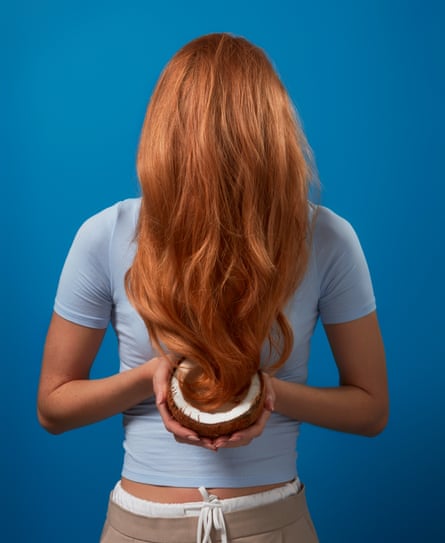
Jack Martin
Colourist based in California who specialises in silver hair. His clients include Jane Fonda and Andie MacDowell
Which bargain product do you swear by?
I swear by a microfibre towel, or even a soft cotton T-shirt, to dry your hair. Most people don’t realise how much damage a regular bath towel can do, especially to silver or chemically treated hair. This one small change can really reduce frizz and breakage. Another inexpensive must-have is a wide-tooth comb, to use in the shower. It protects the hair while detangling and helps maintain the integrity of the strands, especially after lightening.
Which product or treatment is worth splurging on?
A professional-grade heat styling tool – ceramic or tourmaline, with smart temperature control. Silver and light-coloured hair can yellow or burn easily without the right iron.
Which hair trend or treatment would you never recommend?
DIY bleaching. Social media makes it look easy, but the reality is it’s one of the riskiest things you can do to your hair. I’ve seen people melt their hair, break it off or end up with bands of colour that are nearly impossible to correct. I also don’t recommend keratin or permanent straightening treatments on bleached or silver hair. These chemical systems are often too aggressive for already fragile strands and can cause long-term damage or discoloration.
What’s the most common mistake you see in your salon?
People using the wrong products for their hair type or colour. Some overuse colour-correcting purple shampoo until their silver or blond hair looks flat and dull. Others rely too much on high-protein masks and end up with stiff, brittle hair. The other major issue is heat styling without protection. If you’re using flat irons, curling irons or blow dryers without a protective product – especially on pre-lightened hair – you’re going to see yellowing, dryness and breakage.
Which product, treatment or supplement would you recommend for hair loss?
Hair loss needs a multilayered approach. Topically, minoxidil is still one of the most effective treatments. I also recommend scalp serums with caffeine or peptides to stimulate circulation and support follicle health. Using a scalp detox shampoo weekly helps clear out buildup and allows treatments to work more effectively. Supplements such as Nutrafol or Viviscal Pro have also shown great results. They support the body from the inside out by addressing hormonal imbalances, stress and nutritional deficiencies.
For people looking for something more advanced, PRP therapy – where your own platelet-rich plasma is injected into the scalp – can be effective. That said, I always suggest seeing a dermatologist or trichologist first. Hair loss is often tied to underlying health issues, and it’s important to get to the root cause rather than chasing surface-level fixes.

Anabel Kingsley
Trichologist and brand president of Philip Kingsley clinics and product ranges for hair loss
How often do you get your hair cut and coloured?
I get my hair cut every 10 to 12 weeks, but will trim off splits at home every two weeks to keep my ends healthy, and have highlights done every eight weeks.
Which bargain product do you swear by?
Toppik hair fibres are absolutely amazing if you have areas of scalp visibility. The fibres cling electrostatically to your own hair, and it comes in a variety of shades, making it virtually undetectable. I used it myself in the postpartum period when I had a lot of hair fall – and also currently as I’m going through some significant shedding after having awful flu a few months ago. As hair isn’t an essential tissue, it’s the first part of you to suffer when your diet is lacking, so I would also recommend a balanced, nutritious diet.
Which product or treatment is worth splurging on?
If you have female pattern hair loss (FPHL), I’d say prescription hair-loss topicals. For excessive daily hair shedding, AKA telogen effluvium (TE), buying an over-the-counter product is fine, but for FPHL you really do need medicated treatment to see the best results. In my opinion, minoxidil compounded with other hair-supportive actives – such as hormones, anti-androgens and/or anti-inflammatories – works best.
Which hair trend or treatment would you never recommend?
Rosemary oil for hair loss. It doesn’t work. The whole thing stems from one small study done in 2015 that compared the effects of 2% minoxidil to rosemary oil. A 2% strength minoxidil isn’t enough to do much for male pattern hair loss, so the study is basically saying they work as little as each other.
Also, high-dose biotin. Hardly anyone is biotin deficient, so taking it is unlikely to do your hair any good, and it can skew thyroid readings in blood tests.

What’s the most common mistake you see?
I think the term “hair washing” should be changed to “scalp cleansing” – because the real aim of shampooing your hair is to rid your scalp of old oils, dead skin cells, sweat and environmental pollution. I see people avoiding shampooing as they think it’s bad for their hair, when in fact the opposite is true – especially if you have dandruff, which is worsened by the presence of excess oils. If oils are left on your scalp, they break down and become inflammatory.
Unfortunately, what your scalp needs and what your hair likes don’t always align, so it’s a balancing act. But as long as you are gentle when you shampoo and handle wet hair with care, it won’t be damaging to your strands.
Which product, treatment or supplement would you recommend for hair loss?
For FPHL, your core treatment should be minoxidil. It has the most robust evidence behind it and tends to work best when compounded with other hair-supportive actives. If you then want to try other things to support minoxidil’s effect, or you simply don’t want to or can’t use it, you could try microneedling (see a dermatologist), and perhaps PRP or low-level laser therapy.
For TE, you need to do some detective work. Excessive daily shedding occurs in response to an internal factor. Sometimes, the cause is transient – such as flu, Covid or a period of intense stress – and it will resolve on its own. In other cases, thyroid imbalances or vitamin/mineral deficiencies are the driving factor – the most common being ferritin (stored iron), vitamin B12 and vitamin D deficiency – and to treat the hair loss you need to treat the cause, whether that’s with supplements, dietary changes or medications. You will need a blood test to point you in the right direction. Scalp drops containing peptides, caffeine and melatonin can also help speed up recovery. Do not use minoxidil for TE. It will worsen your shedding and simply isn’t necessary in most cases.
If you can, I would recommend seeing a trichologist or sympathetic dermatologist. It can be hard to determine what type of hair loss you are experiencing, and different types can also coincide.

Charlotte Mensah
Founder of Hair Lounge and the first black woman to be inducted into the British Hairdressing awards hall of fame. Her clients include Zadie Smith, Janelle Monáe and Michaela Coel
How often do you get your hair cut and coloured?
I’m embracing my natural grey hair, so I don’t colour it. I do get regular trims to maintain the shape and health of my style – micro trims are important to prevent breakage, as split ends can travel up the hair shaft and cause further damage.
Which bargain product do you swear by?
A silk or satin scrunchie. The smooth, soft material significantly reduces friction, making it much gentler on the hair than traditional hair ties. This helps prevent breakage and split ends. It also maintains hairstyles for longer by minimising kinks and creases.
Which product or treatment is worth splurging on?
Aveda Nutriplenish deep moisture conditioner is absolutely worth the money – it’s deeply nourishing and hydrating. The formula is enriched with a vegan superfood blend of potent plant butter and oils, leaving your hair visibly hydrated and smooth.
Which hair trend or treatment would you never recommend?
I wouldn’t recommend the rice water rinse, especially for those with dry or brittle hair. While it’s praised for promoting protein in the hair, the problem lies in the amount of protein it introduces. Too much protein can actually make damaged hair worse, leading to increased dryness and breakage.
after newsletter promotion
What’s the most common mistake you see in your salon?
Clients having unrealistic expectations, usually because a hairdresser hasn’t taken control during the initial consultation. The most effective approach is to listen carefully to what the client wants, while clearly guiding them towards what is achievable. This not only builds trust but ensures better outcomes for both the stylist and the client.
Which product, treatment or supplement would you recommend for hair loss?
I’d suggest a combination of internal and external support. Viviscal hair supplements are a great place to start. They’re clinically formulated with key nutrients that promote healthy hair growth from within and help to strengthen existing hair.

Johan Hellström
CEO of sustainable haircare brand Björn Axén
How often do you get your hair cut and coloured?
I get my hair cut about every six weeks to keep it fresh and polished. I don’t colour my hair, but I keep my greys cool and unwanted yellow tones away with a silver shampoo that works perfectly for my grey hair.
Which bargain product do you swear by?
Coconut oil – it’s natural, affordable and multifunctional. It’s perfect as a quick hair mask or to tame frizz.
Which product or treatment is worth splurging on?
A really good hairdryer with ionic function. It makes a big difference for both styling and hair health, reducing frizz and drying hair faster, and causes less damage than more basic models.
Which hair trend or treatment would you never recommend?
At-home bleaching treatments. It can really ruin your hair if done incorrectly. Always let a professional take care of lightening your hair.
What’s the most common mistake you see in your salon?
People using the wrong products for their hair type. For example, in pursuit of glossy, healthy-looking hair, many use hair oil. But if you have fine or thin hair, this can backfire, as the hair can’t absorb the product so ends up looking greasy. What works wonders for thick hair might overwhelm finer strands.
Which product, treatment or supplement would you recommend for hair loss?
I would start by reviewing your diet and stress levels – it has more of an impact than you may think.

Larry King
Founder of his eponymous haircare line and London salons. His clients include Jared Leto, Gigi Hadid, Karlie Kloss, Poppy Delevingne, Florence Welch, Chris Hemsworth, Zayn Malik, Tom Holland and David Gandy
How often do you get your hair cut and coloured?
I get it cut every six to eight weeks, I probably leave it slightly longer than I should as I’m always so busy. I usually do it just before I have something important on where I want to look sharp, such as an event. I don’t get it coloured as I am embracing the grey.
Which bargain product do you swear by?
Leave them on the shelf. Invest in good-quality products and tools. Your hair will thank you for it.
Which product or treatment is worth splurging on?
A really good haircut makes such a difference. Pick the top stylist you can afford, so you get the right style for you. It’s something I recommend investing in, if style is important to you.
Which hair trend or treatment would you never recommend?
I would not recommend cutting your own hair. I know it’s all over TikTok, especially cutting your own fringe. Trust me, leave it to the professionals. Hair disasters can take a such a long time to come back from. Yes it will grow back, but it’s better for it to grow back looking good.
What’s the most common mistake you see in your salon?
Do not use box dye, as it is so hard to come back from, becomes a nightmare for your colourist to work with and will end up costing you more.
Which product, treatment or supplement would you recommend for hair loss?
My biggest recommendation would be go to a specialist to take a DNA test. They do a deep-dive blood test that can either show you what you’re lacking, or whether it is a pre-existing DNA issue. That can tell you which treatment or vitamins can benefit you. You can waste so much money just doing it by trial and error.
Minoxidil is a medicinal product available only in pharmacies, under the supervision of a pharmacist. Always read the information leaflet and label

 1 month ago
32
1 month ago
32

















































